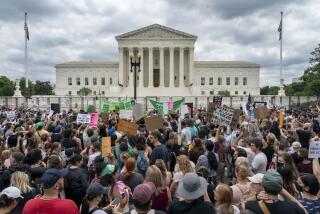Young Males Finally Added to Teen Pregnancy Equation
- Share via
For years, society dumped the problem of unwanted teen pregnancies on girls. We cautioned them about sex, informed them about birth control, introduced them to self-esteem . . . and then sent them back to the same life they left behind. Sometimes, the “family planning” people never saw them again. Sometimes, they came back--the lessons apparently forgotten or never learned.
Then, it was as if the people controlling the dollars suddenly remembered it took two to tango. It wasn’t helping to pay for preventive services if boys and young men were out of the loop, especially when considering that high percentages of the youngest girls--15 and under--were reporting that the sex often was involuntary.
Now, as social workers and others grapple with teen pregnancies, males are moving more toward front and center. When you think about it, not doing so in the past was a little like having Mideast peace talks and inviting only one side.
The analogy isn’t half bad, because in the context of family planning services, boys and men often were considered the enemy. At the very least, they were the perpetrators of the rapes and the pregnancies that the female-dominated field of family planning services was trying to control.
It’s early in this new ballgame, but there are encouraging reports from the experts.
“There is a sense we can get at the problem,” says Cynthia Scheinberg, executive director of the Coalition for Children, Adolescents and Parents.
The agency has applied for state funding of the Male Involvement Program, which broadens the spotlight of teen pregnancies to include teenage and young adult males. CCAP finds out next month whether it can begin March 1 to go after the problem, one that has considerable social fallout.
Consider the following, provided by CCAP:
* In 1993, California had nearly 49,000 non-marital births to teenagers. Nearly 23,000 other teens had publicly funded abortions. Teen births accounted for 12% of all births in California in 1993, and 23% of those were repeat births.
* State and federal costs for welfare programs associated with teen births are estimated at $5 billion to $7 billion annually.
* A recent study indicates that post-high school males, averaging 22 years old, accounted for nearly half of the pregnancies of girls 11 to 14. They accounted for nearly 60% of the pregnancies for girls 15 and 16.
* Four out of five fathers of children born to teenage girls live apart from their children.
The discouraging statistics go on and on, but Scheinberg says the trend isn’t irreversible. A local forum last month directed at men and teen boys was encouraging, Scheinberg says, in that she’s been in the business for 24 years and “was hearing new things from men” about fighting the problem. Teenage boys on a panel indicated that young males need role models and want guidance from their parents, she says.
The teen pregnancy epidemic is more complicated than raging hormones. While that plays a part, Scheinberg says, “it doesn’t have as much to do with sex as people think.” The heart of the problem, she says, is how teens make the transition to adulthood and, more specifically, whether they feel valued and cared for by those around them.
If the grant comes, the maximum would be $180,000 for a 28-month program. That isn’t enough for a countywide program but would pay for programs in “targeted groups,” Scheinberg says.
Statistically, birth rates for Latina and African American teens are almost triple those for whites and Asian Americans. Studies have shown that birth rates correlate to economic and educational status, rather than ethnicity, and that birth rates among racial and ethnic groups don’t vary that much when their incomes and educational levels are similar.
Scheinberg envisions the message getting out primarily through community-based programs, rather than schools. That is more a concession to the volatile politics of sex education than to Scheinberg’s feelings about education, which she says is an ongoing missing element in the teen pregnancy problem.
“The kids we train as peer leaders--who are educated thoroughly--they don’t get pregnant and most of them abstain from sex,” Scheinberg says. “They understand, they’re making choices, and it goes so contrary to what the public opinion is about what education can do in this area.”
If the program kicks in, Scheinberg may still realize a wish made long ago. “I came into this field 24 years ago and wanted to get at these issues before my kids graduated from high school, and now they’ve both graduated from college. Maybe we can for my grandchildren and their children.”
Dana Parsons’ columns appear Wednesday, Friday and Sunday. Readers may reach Parsons by writing to him at the Times Orange County Edition, 1375 Sunflower Ave., Costa Mesa, CA 92626, or calling (714) 966-7821.






